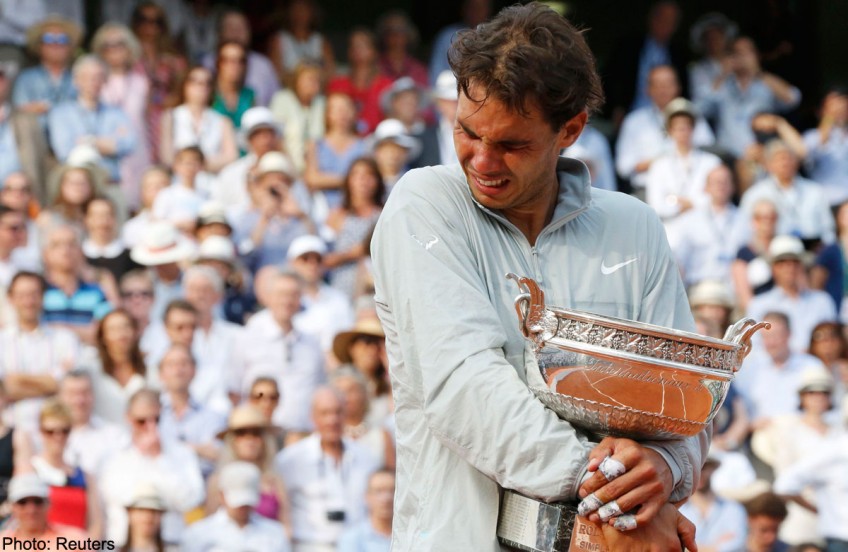Machine-like Nadal's real strength is in steeling himself


For a sweating, crying player who never loses his humanity on court, Rafael Nadal does an excellent impersonation of a machine. One whose warranty card might read as follows:
"Leave out in the rain. Put in the sun. It will work. Run it for 10 years on highest setting. It will work. It might break down but it will repair. Then it will work. If it is over-used, if you drop it, kick it, beat it, manhandle it, it will work less efficiently. But it will work."
There is no confusion in describing this machine: In French, English and Spanish they have the identical word for it - indestructible. Its parts - the knee, the back - are not reliable, yet somehow as a whole it still is. Pete Sampras and Roger Federer win Slams every year for eight consecutive years. With Rafa it is 10.
This machine has a higher threshold for everything, for suffering, for kilometres run, just working, working, till it frustrates, till David Ferrer surrenders, till Novak Djokovic vomits.
Late in the fourth set, the machine is weary, yet it goes on, reminding us of Michael Jordan who once said: "I'm not in control here, it's like somebody's in my body making shots all over the place." Yet there's a heartless message in every Nadal lunge: Break this machine or be broken yourself.
The machine's warranty has to be taken literally, it does not boast. "I try to do my best," Nadal says later, a trite phrase uttered every day in sport, except with him it's a guarantee. He asks that you bring your best and Djokovic did not.
The Serb's backhand, travelling cross-court, is a precision instrument, yet now it hits the net and wanders wide. His second-serve points won for the first five matches is 64 per cent, for the final 36. His unforced errors at 49 are 24 more than the semis. Yes, his stomach's out, his intensity lower, his movement lethargic, yet it's also the effect of the Nadal machine. As if it's interfering with Djokovic's brilliant circuitry.
Forget those fictional films, Rafa in Paris is the real embodiment of the idea of the transformer. On clay he looks taller, his reach wider, his feet faster. He wins only a single clay warm-up (Madrid), admits to fading intensity, loses four straight times to Djokovic, yet he loses only two sets in Paris and of the 21 he wins, three will be 6-0, four will be 6-1, seven will be 6-2.
The machine's beauty is that it adapts and self-corrects and so when those forehands, hit with that sideways dance-step, won't go in, it tinkers and fiddles and makes the forehand work. Down the line. Inside out. Every way.
"Play to the limit, be aggressive" is what the machine knows it must do, but "sometimes you don't have that great feeling and it's difficult to produce this kind of shot". It was cold for days, now humid, the tennis rugged not radiant, tension like a noose, yet somehow the right "kind of shot" at the right time is found.
Strip Nadal down to his basic wiring and you find his plain beauty, in his understanding that nothing is won, it has to be earned. If he becomes his game's greatest player it will be appropriate for he is its greatest competitor.
Jordan, his competitive equal, once profoundly noted that he'd never lost a National Basketball Association final and thus never knew what it felt like. For him, the athlete remained king of the hill till someone knocked him down. "Then you can shake their hand and say, you enjoy it, now you can see how difficult this is."
It tells us pure competitiveness isn't what we assume it is, it's not about perfect endings, but pushing, pushing, till someone pushes you out. Till they earn your place. And this personifies Nadal in Paris, running till exhausted, playing till his shots run fully dry. The machine that fights till someone tells it that its use-by date has arrived.
The best part of Sunday in Paris with Nadal is when it ends, when machine or warrior - any form that you prefer - disappears and a tearful face emerges from behind taped fingers. Then, tired, with cramping hand, he grabs a railing, hauls himself up into the stands and goes to embrace his family. Even in a human movement, the machine is telling us he has more left in him.
Since 2011, four of Nadal's five Slams have come on clay and he needs Paris, it inspires him and yet validates him. Now, alone, he has more French Opens than the eight that France's Four Musketeers - Jean Borotra, Jacques Brugnon, Henri Cochet and Rene Lacoste - have together.
Those men are honoured with statues on the premises and now Roland Garros must consider the unusual: Immortalising an active player in some form. Symbolic of entering an arena of history and the unknown, they should name a gate after Nadal. Built, of course, of old-fashioned steel.

This article was first published on June 10, 2014.
Get a copy of The Straits Times or go to straitstimes.com for more stories.